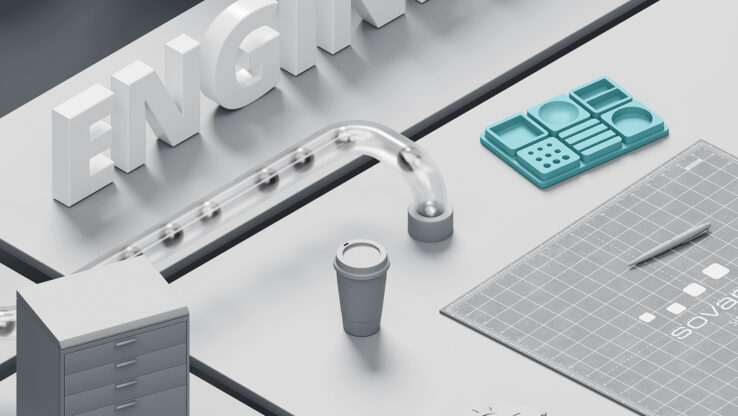
How SAP BTP becomes an Innovation Factory
The SAP Business Technology Platform (SAP BTP) has now become a reality for many SAP customers. Now the question of suitable use cases is becoming louder and louder. Because the question is no longer whether a company is going to the cloud, but how? With which approach and which processes? What is the best way to start? We have therefore identified six specific areas that a company needs to address correctly in order to develop SAP BTP into an effective innovation factory.

1. Human-centered Design
Without use cases, SAP BTP is just an empty technological shell. Filling this shell is the first challenge for a company. This requires identifying who in the company knows which use cases are relevant and what is really needed for them. In all cases, it boils down to the end users who work in the systems and have the digital solutions in use in their daily doing. In order to make the end users’ knowledge of processes, stumbling blocks and system breaks usable for SAP BTP projects, the use of human-centered design lends itself to this approach. Applying this approach, the human being, i.e. the user, is the focus of attention. You metaphorically slip into his shoes and look at existing processes and structures in the company through his eyes. How? By involving the end users from the very beginning of the project, asking them questions, integrating them into workshops, and allowing them to help design the appropriate solutions. And a nice side effect: This turns the end users into real “fans” of the projects right from the start, because they are part of the solution.
2. Enterprise Architecture
Finally know where to reach! With the SAP Business Technology Platform, there is a clear place for innovation. Enterprise Architecture creates the appropriate order and a common understanding of the system and tool landscape in companies. How do I create workflows, how do I use API management, or how do side-by-side extensions look to me? If such topics are clear, projects are accelerated significantly. This common understanding is particularly important in interaction with human-centered design. Because no “castles in the air” should be designed. The better the team knows from the beginning what is possible, the faster and better results will be achieved. We talked about this in detail in a podcast with Andreas Hauser, SVP SAP AppHaus Network.
3. Cloud Agility
It has been shown that working in interdisciplinary, agile project teams leads to sustainable success. Depending on the type of project, different roles and skill sets come together. From the user experience designer to the solution architect to the backend engineer and frontend developer, from the DevOps expert to the quality assurance specialist to the product owner and SCRUM master – the list could go on and on. The actual composition depends on the project and the chosen approach. But what is always a basic prerequisite: the right cloud mindset. Because when you work in a cloud environment, you work differently. Personal development, lifelong learning to keep up and self-organization are required to keep up with the new pace of innovation in the cloud. The corporate culture must therefore change permanently through the use of SAP BTP.
4. DevOps
However, the described dynamics and agility in the cloud can only be achieved with the right technical setup. The DevOps options in the SAP BTP simplify and automate many steps and enable even smaller teams to safely achieve short (2-week) release cycles for their solutions. On the one hand, developers on SAP BTP benefit from the “openness” of SAP Cloud Foundry Plaform. Unlike in the past, developers can now also benefit from the tooling and approaches from the non-SAP world. On the other hand, SAP BTP also comes around the corner with a few tricks and configuration options that significantly simplify the daily lives of DevOps experts.
5. Governance
What is the downside of dynamism? If mismanaged or poorly managed, such dynamics can quickly become chaotic. That’s why companies need to establish appropriate governance at an early stage. “What” must be documented and ensured “who”, “how”, “where” and “when”? This is the only way for companies to maintain an overview despite speed, dynamics and innovations. The balancing act between a sufficient degree of freedom and disciplined processes and procedures is important here. There should be no exaggerated and complex governance constructs that directly slow down the newly gained dynamism.
6. Education
We speak of an Innovation Factory as a matter of course. But who will end up working in the factory? It is difficult to find experts for these areas on the market, the topic is still relatively fresh and no one can look back on years of experience on SAP BTP. And so, of course, young talent with SAP BTP know-how is hard to find. For this reason, companies that want to successfully build an Innovation Factory on the SAP BTP cannot avoid the topic of “training”. A hands-on and pragmatic approach needs to be implemented. The good news is that there is sufficient training content available online for newcomers or career changers, and it is easy to consume.
Do you also want to make the SAP BTP your Innovation Factory?
We will be happy to accompany you on your way there and help you tap the right channels internally as well as build up processes and team structures. We look forward to hearing from you.




